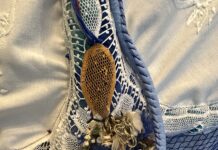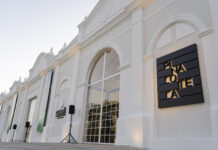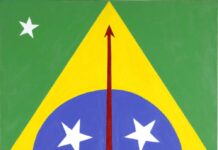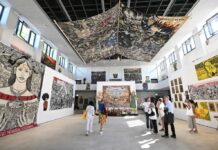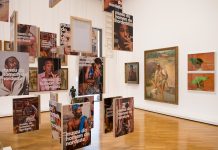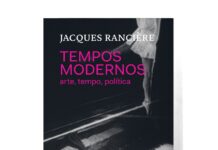the artist Joseph Beuys was born on May 12, 1921 in Krefeld, Germany, near the Netherlands. In this pandemic year, therefore, his 100 years of birth are celebrated. A precursor to issues that we are systematically debating in these months of confinement, such as the defense of nature, his figure also stands out for rethinking the art system. This theme was addressed by me in a lecture at the Goethe Institut in 2011, in the Third Cycle of German Thought, which turned into a chapter of a book with the same name of the event the following year. The actuality of the debate is maintained and we consider it appropriate to now republish the text, without major modifications.
***
One of Beuys’ most significant works is The End of the 20th Century (Das Ende des 20. Jahrhunderts) (1982-83), exhibited at the Hamburger Bahnhof museum in Berlin, an installation composed of 21 basalt rocks that can represent numbness, solidification or even a collective cemetery. Basalt, it is good to remember, contains crystals that are not seen with the naked eye. On each rock, the artist made a circular hole and from there removed a cone, reintroducing it again, this time glued with felt and clay, as signaling that even the most solid and immutable can undergo transformations through human action.
According to Peter-Klaus Schuster, curator of the exhibition The 20th Century: A Century of Art in German – which took place in three major museums in Berlin in 1999, and which placed Beuys as the central artist of his selection on German art in the 20th century -, The End of the 20th Century deals with the “ambivalence of the enormous catastrophes of the century and at the same time , as a positive image of the value of human life.”
It is this essentially humanistic vision, which elects every man not only as a revolutionary, but also as an artist, responsible for contributing to the construction of a new society, defined by Beuys as “social sculpture”, which places him as one of the leading thinkers of the 20th century and whose ideas I intend to address in this text The abandonment of art – inspired by a postcard from 1985 , entitled With this I abandon art – to reflect on the absolutely radical character of its propositions.
The original title of this work, moreover, is Hiermit trete ich aus der Kunst aus and the translation I adopted is that in the book Joseph Beuys, by Alain Borer. Literally, it may not be the most appropriate translation, but conceptually, as we’ll see below, it’s totally pertinent.
1. Beuys: the myth
To understand Beuys’ thinking it is essential to know his own biography. This is not about justifying his work as an illustration of his life, but of the very interrelationship he sought between art and life, a link that became essential in the way art was conceived in the 1960s and 1970s, a period that has in Beuys one of its main figures.
This particular moment of the 20th century caused artists such as Andy Warhol, Hélio Oiticica or Beuys himself to create around him a series of legends, as a symbolic sample of his conceptions of art. Each, in his own way, has created upon himself a series of legends that, whether true or false, it doesn’t matter, are the way they embodied their own conception of art.
In Beuys’ case, his uniform was always that of a simple type: the felt hat, the fisherman’s jacket, the jeans and the heavy shoes, as someone ready to work in one of the oldest professions. The construction of his public figure, a kind of fisherman of souls, still relates directly to the legend that the artist built around his biography. As Borer says, in the quoted publication:
A legend is neither true nor false, it is, in Latin, what must be read and said, what is narrated about the work and its author, “the point at which the biography ceases to be extrinsic”: all that with which the legendary figure contributes and collaborates to the extent that the artist himself watches zealously, and this in every work, what will be said about it. (BORER, p. 12)
It is thus, therefore, that we should read the mythological story of Beuys and his plane crash in Crimea: as a preamble to his work. It is narrated, in his biography published by Heiner Stachelhaus, as follows:
At a young age, he began the study of medicine, intending to devote himself to the humblest. This desire, however, was destroyed when flying his Stuka, after joining the Luftwaffe [the Nazi air force] in 1941. In 1944, at the age of 22, he miraculously escaped death in Asia. His plane, a JU 87, crashed in a snow-covered region called Crime or Crimea. Joseph was unconscious for several days, semi-frozen, was taken by genuine Tatars, who took care of his wounds. The people, born in the place, soon took him for one of his own: “You don’t German, you Tatar,” and brought him back to life, wrapping him in his traditional felt blankets and heating him with animal fat. After his return, having found shelter on a farm, Joseph faced a deep crisis, familiar to all great artists, which allowed him to elaborate the basic principles of his art. (BORER, p. 13)
We must not forget that Beuys assumes there that he participated in the Nazi squadron and his martyrdom thus becomes a kind of redemption, as if he were transformed so vitally with this episode that he had a genesis from the help of the Tatars, with his fraternal and primordial means of rescue.
It is from this story that Beuys justifies not only the character of his artistic propositions as a field that must save the human being from his crises, giving them a therapeutic character; but it also explains the materials involved in his works, especially felt and animal fat, elements that represent a form of protection, through heat, as organic materials that enable a vital relationship to nature, remembering how the human being is an integral part of it.
Art should not be limited to the retina – so I am engaged with substance, as “a process of the spirit (soul)” (HARLAN, p. 14).
It is how Beuys justifies the use of natural elements in his work. In the 1981 version of Chair with Fat (the first was performed in 1964) or in Felt Suit, 1970, we see how the artist is not concerned with creating a sculpture in a traditional way, but in provoking a reflection on the role of the artist, building a narrative from these materials. Thus, Beuys is concerned with reorienting the meaning and function of art.
During Nazism, modern art was officially fought through the Degenerate Art exhibition, a kind of manifesto against modernist movements such as the Bauhaus, Cubism and German Expressionism, which preached in art a new way of observing the world. What the Nazis defended, then, was the return of fine arts, in classical forms as the most appropriate to Aryan society that was intended to erect itself as sovereign.
Degenerate Art, the exhibition that began at Munich’s Haus der Kunst in 1937, and then moved to 11 more cities in Germany and Austria, brought together 650 works by 112 artists, including Paul Klee, Kurt Schwitters, Marc Chagall, Mondrian and Lasar Segall. In four months in Munich, the show gathered more than two million visitors.
Almost twenty years later, in 1955, Arnold Bode created in Kassel an exhibition, Documenta, whose central objective was to reintroduce to the German public the modernists censored in the Nazi regime. This exhibition, which would happen every five years, and today functions as the great beacon of contemporary art, was one of the great platforms used by Beuys for his ideas. He participated in four of his editions – in 1964, 1972, 1977 and 1982 – contributing to the reconstruction of German artistic thought decisively. And what was that way? In Beuys there is an essential question: “What is the need that justifies the creation of something like art?”. And your own answer is pretty clear:
If this question does not become the central focus of such research, and is not resolved in a truly radical way that actually sees art as the starting point for ducing anything at all, in every field of work, then any thought of further development is just a waste of time (HARLAN, p. 10).
When Beuys argues that art is the starting point for producing something in any field, he is in tune with those who, in the 1960s and 1970s, saw in art the only possible space for new practices that would discondition the human being from at least two then hegemonic visions, faces of the same civilizing process, as described by Norbert Elias: the rationalist thinking and the conditioning of the body through forms of behavior then seen as civilized, but which opposes it to the forces of nature, as if man were excluded from them.
One of the central points of Beuys’ thought is precisely the “defense of nature”, as he preaches in a work, a photograph from 1984, in a holistic conception, which is largely related to Rudolf Steiner’s anthroposophy (1861-1925), that is, the need for integration between man and nature. It is from there that, explains the artist, his work must be understood.
My objects are to be seen as the stimulants for a transformation of the idea of sculpture, or of art in general. They should provoke thoughts about what’s culture can be and how the concept of sculpting can be extended to the invisible materials used by everyone:
Thinking forms – how we mould out thoughts or spoken forms – how we shape our thoughts into words or
SOCIAL SCULPTURE: how we mould and shape the world in which we live: Sculpture as an evolutionary process; everyone artist (HARLAN, p. 9).
In this way, we come here at the heart of Beuys’ conception of art: to use art as a platform for the transformation of society as a stimulus for the reconstruction of the world. As Harlan states in another publication:
The main concern of his artistic work is the reformulation of the social field. He calls the social body social sculpture (FARKAS, p. 27).
However, it is not a purely political platform, Beuys is not only a militant of transformation in the social field, but also a revolutionary of plastic forms, so his discourse and artistic practice cannot be separated: “Art is a type of science of freedom” (HARLAN, p. 10), says Beuys, in a conception very close to that advocated by Brazilian art critic Mário Pedrosa , for whom “art is the experimental exercise of freedom, its idea best known and prowed”.
Beuys used various means as instruments for disseminating his ideas. He was the author of a monumental production, dozens of works, but especially multiples, which by their democratic character, another of the flags of the 1960s and 1970s, were more suited to his proposals. Between 1965 and 1986, he produced no fewer than 557 multiples, some with a circulation of 12,000 copies, such as the wooden box written “Intuition!”. He also produced about 300 posters, still appropriating propaganda as one of his means of expression, the same as the Nazi regime did, but obviously with totally different goals.
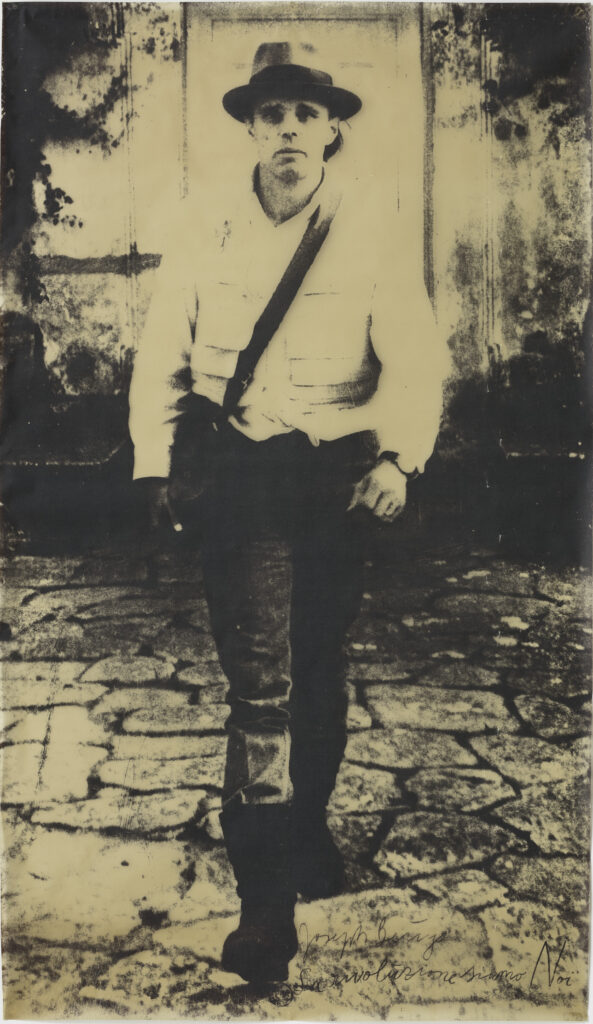
When Beuys created the poster The revolution are we, in Naples, in 1971, he explained, in an interview with Giancarlo Politi, of Flash Art magazine (n. 168), the meaning of the use of this medium:
To communicate, man uses language, uses gestures, writing, spray a wall, picks up the typewriter and extracts letters from it. In short, it uses means. What means to use for political action? I chose art. Making art is therefore a means of working for man in the field of thought. This is the most important side of my job. The rest, objects, drawings, performances, come second. Deep down, I don’t have much to do with art. Art interests me only while giving me the possibility to dialogue with man.
Here, then, we see a little of the meaning of his postcard, which gives title to this speech, With this I abandon art. The art, for him, was not reduced to conventional spaces, the gallery and the museum, even though he also regularly occupied these places.
2. The places of Beuys
2.1 The academy
To defend his proposals, Beuys used and problematized several fields: the academy, art institutions such as museums and galleries, political institutions, and became one of the founders of the German Green Party in 1980. His presence at the Düsseldorf Academy of Art, for example, was remarkable. There he studied, became professor of sculpture in 1961, and remained for ten years until 1972. For him:
It’s my most important function. To be a teacher is my greatest work of art. The rest is the waste product, a demonstration. If you want to explain yourself you must present something tangible. But after a while this has only the function of a historic document. Objects aren’t very important for me anymore. I want to get to the origin of matter, to the thought behind it (Artforum, 1969).
In this sense, Borer states that in Beuys, “speech is sculpture”, as if his thought materialized in the dialogical relationship with the students.
His classes were very disputed and this facet is the motto for the exposition Beuys and well beyond – Teach as art, organized by Deutsche Bank from its own collection, on display at the Tomie Ohtake Institute [in 2011], which also features works by students such as Blink Palermo, Katharina Sieverding and Lothar Baumgarten, in a somewhat formalist approach, which I intend to address later.
In Düsseldorf, “traditional and strongly hierarchical forms of class were replaced by collective debates, in which both art and social issues were discussed.” In 1971, Beuys came to occupy the secretariat of the Academy of Art, to protest the restrictions on the admission of students, then founding the Organization for Direct Democracy by National Referendum.
A little earlier, that same year, he had already admitted in his class the 142 candidates who were turned down by the Academy, but this set of protests ended up costing him the job and a lawsuit, which he won in 1978. Fundamental here is to reinforce the libertarian character of his activity as a teacher, which represents enabling each student to develop his own work, regardless of their jobs, as he stated in a 1972 interview:
It is often said that in my classes everything would be conceptual or political. But for me it is very important that it results in something sensually palpable, with broad epistemological foundations. My main interest there is to start with the language and let the materializations follow as a correlation of thought and action. The most important thing for me is that the human being, through his products, experiences models of how to co-act in the relationship with the whole; and not only produce articles, but become a visual artist or architect in the entire social organism. The future social order will be formed according to the principles of art (CHRISTENSEN, p. 12).
His belief in the power of institutional education does not end with his departure from the Düsseldorf Academy of Art in 1971. Three years later, he founded the International Free University (F.I.U. – Freie Internationale Universität), which served for the development of many of his projects, such as Seven thousand oaks in the Documenta de Kassel in 1982.
In Documenta itself, but in 1977, in its 6th. Edition, The F.I.U. was responsible for organizing Honey Bomb in the workplace, a room in which Beuys and his collaborators spent a hundred days – the usual time of duration of the show, debating the “social sculpture”, that is, the new model of society. However, the F.I.U. was not created as simply an alternative to the German university system. As Beuys declared in 1985:
The International Free University is an international research community. Its circle of collaborators is relatively small. It is not possible to attend the F.I.U. It is simply the project of a new society, beyond capitalism and communism. To accomplish this task, each has to find support in himself. (FARKAS, p. 45)
As in all of Beuys’ work, F.I.U. also did not constitute a conventional structure of established standards, but proposed a new possibility to disseminate the artist’s thinking in a pragmatic way. To think, in Beuys, is to realize.
2.2 The political system
In 1979, the F.I.U. was one of five organizations that created the Green Party in Germany, making Beuys one of its founders. Before, in 1967, he had already created the German Student Party (Deutsche Studentenpartei) on the eve of the revolutions of May 1968.
Then, in 1970, he created the Organization of Non-Voters – Free Plebiscite (Organisation der Nicht Wahler, Freie Volksabstimmung), and in 1971, because of the crisis at the Dusseldorf Academy of Art, the Organisation for Direct Democracy by Plebiscite (Organisation fur direkte Demokratie durch Volksbastimmung). All these organizations demonstrate how much Beuys believed in transformation by institutional means, at a time when Germany was shaken by associations that also sought change, but by illegal means, such as the far-left guerrilla group Baader Meinhoff, which existed between 1970 and 1988. The use of instruments of direct democracy also points out the importance of the thought of each individual, against the principles of representative democracy.
Even so, Beuys went on to run for the European Parliament in 1979 for the group Other Political Association (Sonstige politische Vereinigung), which the following year would become The Greens. On that occasion, he launched the manifesto “Call for the Alternative”, published in the Frankfurter Rundschau newspaper on 23/12/1978, and reprinted in 1979 for the first election to the European Parliament. The text advocated non-violence, the transformation of the use of money and the organization of the State, questioning the escape from reality and even the use of drugs. This manifesto became the poster that integrated its participation in the 15th Bienal de São Paulo, with the title Call for a global alternative, in 1979.
From 1980 to 1986, the Greens maintained, under the direction of Johann Stüttgen, a coordinating office in room 3 of the Academy of Dusseldorf, the former Beuys room.
2.3 The art system
On December 11, 1964, Beuys presented the performance Marcel Duchamp’s silence is overrated (Das Schweigen von Marcel Duchamp wird uberbewertet), an action broadcast live on German TV ZDF, as a member of the Fluxus group, using in addition to speech, its typical materials such as fat and felt.
Duchamp was an indolent who created beautiful and interesting provocations for the bourgeoisie and made the affronts brilliantly in the aesthetic typology of his time. (CHRISTENSEN, p. 32)
This anti-Bourgeois spirit in Beuys’s speech is exactly one of the main characteristics of the Fluxus group, created in 1961 at the ag gallery in New York by Lithuanian artist George Maciunas. With an international character, Fluxus was not characterized by a formal style among its components, but by a common principle: to abolish the objectual question of art as the primacy of its existence and to value the process in its constitution.
Beuys joined the group through colleague Nan June Paik, a Korean artist who was also a teacher in Düsseldorf. In addition, also participated in the events organized by Fluxus artists such as the American musician John Cage, whose experimentations were decisive for the group, and the Japanese Yoko Ono. At Fluxus festivals, Beuys performed especially actions, anticipating the idea of performance, which had not been characterized as a language.
Fluxus is linked, in general, to the anti-art character of the Dada movement, which also used everyday elements and ephemeral actions, questioning the commercial value of art. Maciunas, for example, created several multiples, such as the Fluxus Boxes, an idea that would then be used by Beuys. The use of the video, especially due to the influence of Nan June Paik, was also recurrent in Fluxus, not only because of the emergence of the new medium, but because of the characteristics it provided, that is, the possibility of its retransmission, which would also be widely used by Beuys. However, while the Dada had a negative character, as Giulio Carlo Argan defines, by “demonstrating the impossibility of any relationship between art and society”, Fluxus had a more positive view, which sought to link life and art.
It is remarkable that Marcel Duchamp’s silence is overrated occurred just inside a Fluxus event, because its members had great appreciation for the french artist creator of the ready-made. Beuys’ connection to Fluxus was intense, but it did not last long, and the performance shows how the german artist’s critical character was in the confrontation, within the very space of the institutions where it worked.
This capacity for criticism also occurs in the performance I like America and America likes me, in May 1974 for three consecutive days, eight hours each day, on the occasion of the opening of the gallery of the German René Block in New York.
Beuys arrived in the U.S. by plane and, from JFK airport, set off in an ambulance, going straight to a cage built in the gallery, where he lived with a coiote, an animal considered sacred by the native peoples of the usa. According to the myth of the performance, after three days, the artist would have been taken back to the airport, without having stepped on American soil.
Beuys had been working with Block for a long time. It was in his gallery that he once covered the corners with fat, rounding the rigid shape of his architecture, bringing to it an organic character, which was transformed over the days when the fat was exposed. Here one can see how Beuys cares about the plastic issue, but it is a vehicle for his ideas.
In I like America… their action is more radical. He lives with an animal, wrapped in felt and, leaning on a cane, approaches the interactivity with nature, so important to the idea of “social sculpture”. The performance, in fact, points out how the artist lived his own utopia in his work, showing that the realization of his proposals is feasible, besides pointing out a character of non-objectual art, non-commercial, anti-representational. This is because Beuys, who called himself “a reincarnated caveman” (BORER, p. 30), was living his proposals, was not creating mere illustrations for them. Experience is an essential part of your actions.
This action is also a good example of how, in Borer’s conception, Beuys can be seen as a pastor:
The pastor leads his disciples to a place only he knows – a promise of a higher state; he is the man looking for a path, a path more extensive and vast than him: he opens passage.(BORER, p. 23)
This occurs in a great way in his project Seven thousand oaks, which the artist started in 1982, on the occasion of Documenta 7, created from F.I.U. Its goal was that 7,000 such trees be planted throughout the city, always next to a basalt column. Again, one sees here the insightful ability of Beuys to work with images: to this day, those who visit Kassel face the oaks planted by Beuys and his collaborators.
The symbolic beginning of the vital reforestation of the Earth must take place in Kassel. […] This is a rational action; in this case, tree planting. […] One must first create a global understanding to – wherever possible – make such processes sustainable. (FARKAS, p. 41)
In Seven thousand oaks, Beuys concretizes his idea of “social sculpture” transforming the environment. And it does so with the collaboration of those who are willing, so that each person who lives on Earth can become a creator of forms, a sculptor, a designer of the social organism.
However, all the radicality that marked the period of consolidation of Beuys’ work in the 1960s and 1970s, with the exercise of extensive dialogue with other artists and groups such as Fluxus, and Arte Povera in Italy, and the strong presence of performance artists such as Marina Abramović and Ulay, will transform in the following decade.
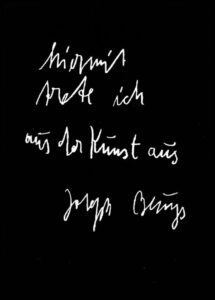
The 1980s are marked by the idea of the “return to painting”, especially in Germany, with the emergence of so-called neoexpressionists such as Georg Baselitz and Anselm Kiefer. This new context was certainly very discouraging for Beuys, which probably led him to create the multiple postcard With this I abandon art, on November 1, 1985, almost three months before he died, on January 23, 1986, due to a heart attack.
This postcard is part of a series of nine sentences, all handwritten, in chalk, on a dark background, just like a blackboard, material he so often used in his works, related to his teacher facet. It should be noted that, knowing himself ill – Beuys had long been weakened as a result of his plane crash – he leaves this last set of works where there is no image, no color, only text. Another of the texts written in this series of postcards is: “The error already begins when someone prepares to buy a screen”(der Fehler fängt schon an, wenn einer sich anschickt, Keilrahmen und Leinwand zu kaufen)
Therefore, the message of the postcards is clear: Beuys no longer saw the possibility of conveying his ideas in the field of art, nor taking part in it. Just as he was fired from the Academy, and never elected by his political associations, the artist found that neither in art his message achieved the necessary repercussion. An emblematic artist of an experimental period in art history, which begins in the post-War period, Beuys arrives pessimistic in the 1980s, when the art market gains strength and power again and the experiments move into the background. It is the decade of the end of history and, according to Arthur C. Danto, the end of art.
Beuys participated in all the important shows of the art circuit: four times in Documenta; once at Skulptur Münster in 1977; represented Germany in Venice, in 1976 with Tram stop- Monument to the Future; and in 1980, with Das Kapital Raum from 1970 to 1977; he also represented Germany in three Biennials of São Paulo (1979, 1985, 1989) and was consecrated with a retrospective at the Guggenheim in New York in 1979, which earned him great prestige in the United States.
His epitaph, however, points out that, in fact, these great exhibitions represented little for Beuys, and that he already envisioned an unpromising future for art. Sad observation for who argued that:
Only art, that is, art conceived at the same time as creative self-determination and as a process that generates creation, is capable of freeing us and leading us towards an alternative society (BORER, p. 28)
Bibliography*
CHRISTENSEN, Liz (org.) (2011). Beuys and well beyond. Teach as art. Frankfurt: Deutsche Bank.
BORER, Alain. (2001). Joseph Beuys. São Paulo: Cosac Naify.
FARIAS, Agnaldo. (2001). Bienal 50 anos. São Paulo: São Paulo: Fundação Bienal de SP.
FARKAS, Solange (2010). A revolução somos nós. São Paulo: Associação Cultural Videobrasil/Sesc.
HARLAN, Volker (2004). What Is Art?: Conversation with Joseph Beuys. East Sussex: Clairview Books.
SCHUSTER, Peter-Klaus (1999). Das XX. Jahrhundert: ein jahr hundert kunst in Deutschland. Berlin: Nicolai.
*Some of the bibliography was translated from Portuguese to English, therefore, the present text may differ from original.
Leia em português, clique aqui.


